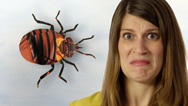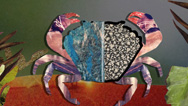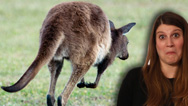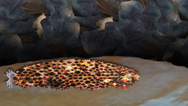Flesh-Eating Amphibian Babies
- By Anna Rothschild
- Posted 05.07.15
- NOVA
Legless amphibians, called caecilians, have a very strange way of feeding their young. Learn more in this episode of Gross Science.
Transcript
Flesh-Eating Amphibian Babies
Posted: May 7, 2015
You know how your parents might tell you they’d give you the shirt off their back? Well, in the animal kingdom there’s one mother who takes the expression a little too. I’m Anna Rothschild and this is Gross Science.
So, there’s this group of animals called caecilians that live underground in rainforests throughout most of the world. They look kinda like a cross between a snake and an earthworm but in reality they’re neither. They’re actually amphibians, which means they’re related to frogs and salamanders.
Different species of caecilians give birth in different ways. Some species are viviparous, which means they give birth to live young, while others are oviparous, which means they lay eggs. For years, scientists were puzzled by something about certain types of egg laying caecilians. You see, after hatching, the babies would rapidly gain weight—in one species, increasing their mass by 86% in just 20 days. But, no one knew what they were eating that would allow them to mature so quickly.
Then a few years ago, scientists studying these caecilian mamas and their babies observed a crazy thing. In frantic bursts, the babies would attack their mother, tearing off portions of her flesh with their teeth and eating it. Now, turns out, these weren’t just some particularly deranged youngsters. This behavior, called “maternal dermatophagy,” doesn’t hurt the mother at all. In fact, she grows this layer of especially fatty skin specifically for her babies to eat. And after two to three days, the delicious skin grows back, ready to be devoured again.
Other species of caecilians have different, but equally strange ways of feeding their young. The babies of certain viviparous species have specialized teeth that they use in the womb to feed on the lining of the mother’s uterus.
When you think about it, maternal dermatophagy is really quite similar to breast-feeding in humans. The mother produces a food source from her own body for her offspring to consume. And when you put it that way, legless babies peeling their mother like a piece of fruit starts to seem like a beautiful thing.
Ew.
Credits
PRODUCTION CREDITS:
- Host, Writer, Animator, Editor
- Anna Rothschild
- DP, Sound, Researcher, Intern Extraordinaire
- Elizabeth Gillis
- Many thanks to Dr. Emma Sherratt.
- Monkfish (b)
- Music Provided by APM
IMAGES
- S. vittatus
- © john@measey.com
- Images ofMicrocaecilia dermatophaga
- © 2013 Wilkinson et al (PLos ONE)
- Christian Charity
- Il Guercino/Public Domain
SFX
- Cockroaches
- Freesound/StateAardvark
(used with permission from author) - Squeak Pack/squeak_10
- Freesound/Corsica_S
- BUBBLES POPPING
- Freesound/Ch0cchi
- Crumple Dry Leaf 1
- Freesound/elliotlp
- Biting an Apple
- Freesound/thedapperdan
- Produced by WGBH for PBS Digital Studios
IMAGE
- (main image: Babies eating skin)
- ©WGBH Educational Foundation 2015
Sources
Want more info?
Wilkinson M, Sherratt E, Starace F, Gower DJ (2013) A New Species of Skin-Feeding Caecilian and the First Report of Reproductive Mode in Microcaecilia(Amphibia: Gymnophiona: Siphonopidae). PLoS ONE 8(3): e57756. doi: 10.1371/journal.pone.0057756
http://journals.plos.org/plosone/article?id=10.1371/journal.pone.0057756
Related Links
-

Gross Science
Bizarre stories from the slimy, smelly, creepy world of science.
-

The Castrating Zombie Parasite
This parasite makes male crabs think that they’re pregnant females.
-

Kangaroo Gas and Global Warming
Can kangaroo farts teach us how to make cattle and other livestock more eco-friendly?
-

Sea Cucumber Evisceration
Sea cucumbers can expel their internal organs and then regrow them.

